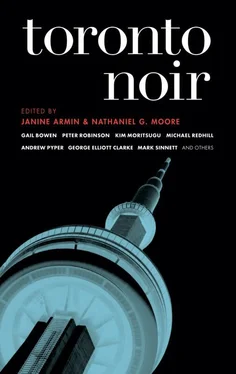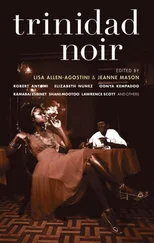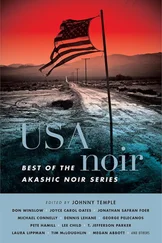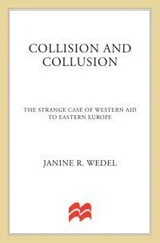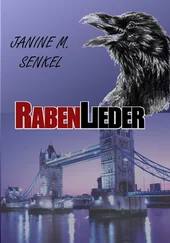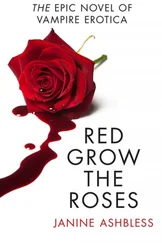
Introduction
To noir a good night
In 1834, York, city of mud and canons, became Toronto, city of trauma and free refills. Depending on what side of the CN Tower you stand under, Toronto is histrionic or claustrophobic, gelling or uncool. It’s the 1967 Stanley Cup champion Maple Leafs; it’s a fading World Series Blue Jays souvenir cup. It’s gaggles of language-starved landfill stalkers who text and Facebook and spit wads of bubble gum onto the world’s cleanest tarmac.
With its simple gestures, a stolen blue bike, a red balloon caught by a fraying string on Oakland Avenue, Toronto bids for more than the Olympics. Frustrated and frustrating, it teems with forensic experts and film-set extras trying to interpret our troubled conscience.
Even though it’s North America’s most multicultural metropolis outside of Miami, it’s more commonly known for its cold winters, strong beer, and variety of transportation options. Perhaps that’s why it’s so disorienting. As Gail Bowen notes in “The King of Charles Street West,” Come in and get lost is strategically emblazoned on Toronto’s landmark five-and-dime Honest Ed’s. The Toronto Transit Commission has moved over twenty-five billion people since 1921, almost four times the world’s population. And while the transit monopoly searches for its next light rail train, others search for their next breath, meal, or kiss.
Toronto Noir lets a bit of moonlight contour the ever-mobile city, allowing a glimpse, a brief catch and release. Sentimentality and deception bring these stories together. Dog-ear this book, use it as foreplay for further encounters on your coffee table. Sift through the stiff pages written by people who inform and present their city in a way no double-decker gimmick bus whizzing past the Rogers Centre and Casa Loma could ever hope to do. It is in our emergency rooms and carrying our groceries home that we are Torontonians.
Some of our youth emulate high-octane luxury-car drag racing video games and kill taxi cab drivers one day shy of becoming a Canadian citizen. Others try and steal Michael Stipe’s microphone when he passes it down to the audience during a free concert at Dundas Square. Some nights we listen and judge, while others, the air has a pulse and bodies clog the carb-heaving arteries of concrete. Some nights, living isn’t enough and words are all we have; they blow them out without leaving a note or forwarding address.
Some leave us, while others like Margaret Atwood, Michael Ondaatje, and Ken Dryden carry the torch. The city is haunted by ghosts that sometimes get parks named after them: Gwendolyn MacEwan, Oscar Peterson, Jeff Buckley, Timothy Findley. Musically, Toronto spars with New York. The Barenaked Ladies, Broken Social Scene, Ron Sexsmith, Gordon Lightfoot, Glass Tiger, Platinum Blonde, and Triumph all got their starts here.
Not that anybody knows. Toronto grounds itself in its unknowing.
Working and living under the Great North, Toronto Noir ’s authors share the weight of the unseen and the dying. Music binds Mark Sinnett to self-erasure and Peter Robinson inflects domestic problems with the twist of a foreign knife. Heather Birrell takes us to Ecuador and shows us how maternal longing can be an evil thing.
“A writer uses a pen instead of a scalpel or blowtorch,” says Ondaatje. Here, Peter Street’s clubland spawns nightly crime-scene sound bites. In the West End, bucolic mansions are usurped by halfway houses. Bollywood screenings warm up Little India on murderously cold winter nights, while cadavers conceal their wares in cemetery-riddled East York.
In the end, physical acts and written acts share a parasitic need to enjoy and to tolerate. So clash away, city by the lake, it all comes down to communal passions: crimping your hair, making deviled eggs, varnishing the deck, not calling someone back, ever.
These stories capture encounters that happen every day. They resurrect the brutish moments displaced by high school graduations and taxi strikes, preserve them in metaphor, wrap them in gauze. Except here we let the carnivorous parchment swell heavy: a panting mascot, tied outside a bank, awaiting the return of its owner.
Come in, and get lost.
Janine Armin & Nathaniel G. Moore
Toronto, Ontario
February 2008
The King of Charles Street West
by Gail Bowen
Dundas Square
Toronto was in the tenth day of a garbage strike when Billy Merchant came back into my life. The city was sweltering, and the stench that rose from overflowing cans, fetid dumpsters, and cardboard boxes swollen with rotting produce hung above the hot pavement like a poisoned cloud. We were a city ripe for a plague, so it was no surprise when I picked up the Toronto Star that morning and saw Billy’s photo staring up at me. I hadn’t seen him in forty years. If he’d let Mother Nature take her course, I wouldn’t have recognized him, and he could have kept his empire for himself. But Billy never met a mirror he didn’t like, and he was rich enough to believe he could defeat time. Judging by the picture in the Toronto Star , he had either discovered the fountain of youth or invested in a perpetual makeover: His hair was still thick and black as the proverbial raven’s wing; his body was toned; his jawline smooth and his smile dazzling.
He didn’t look young — he looked carved, like one of those figures at the Movieland Wax Museum in Niagara Falls. Except, unlike the wax Jack Nicholson or the wax Harry Potter, Billy Merchant hadn’t been captured in his most memorable scene ever — at least, not the one I remembered. Billy with his cool, slender fingers around my throat whispering, “If you ever tell anybody what you saw, I’ll kill you.”
I hadn’t doubted him for a moment. Billy had his weaknesses, but he wasn’t given to idle threats. Besides, twenty feet away from me, at the bottom of the basement stairs of the rooming house where we lived, there was a dead man and I had watched as Billy killed him.
“It’s hard to make predictions — especially about the future.”
— Allan A. Lamport, Mayor of Toronto
For four decades, I’d kept our secret. I had my reasons, but when I saw the cutline under Billy’s photo calling him The King of Charles Street West, something stirred inside me. A preacher or a poet might have called that stirring a thirst for justice, but I wasn’t a preacher or a poet. I was an ordinary woman who lived in a nice house off the Danforth with too many pictures of my son and too many memories, so I did what an ordinary woman does when she contemplates blackmailing a murderer: I made myself a cappuccino, peeled an orange, and sat down to read the paper.
The article about Billy was nice — inspiring even. Much of it was in Billy’s own words — about how forty years ago, as a twenty-year-old with a high school education and two years working construction under his belt, he moved to Toronto, found a place to live in a rooming house on Charles Street West, got a job waiting tables, worked hard, and saved every penny. According to Billy, his landlord, a Russian immigrant without living kin, admired his work ethic, and the men developed what Billy characterized as a father-son relationship. Then came the happy ending. When the older man died, it turned out that he’d left Billy his house. Starting with the property he’d inherited on Charles Street West, Billy began to sell, mortgage, lease, invest, and purchase until he owned an impressive chunk, not just of Charles Street West, but of Metropolitan Toronto.
Читать дальше
